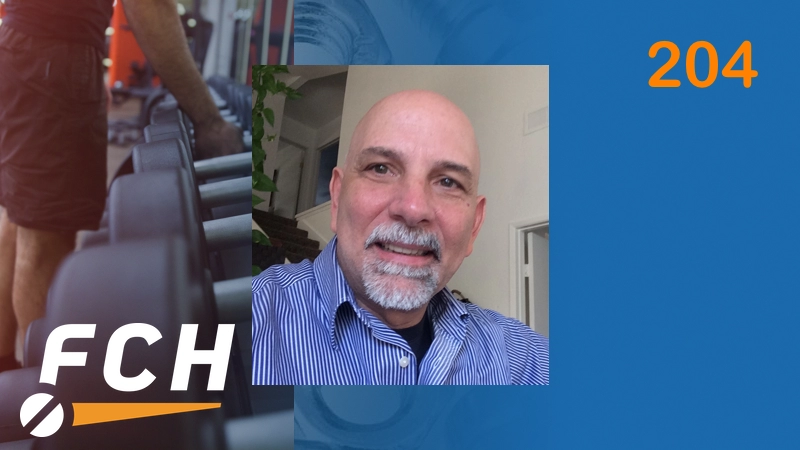This edition of the Fastener Training Minute with Carmen Vertullo was originally published September 20th, 2024 as “The high-strength fastener material of the future, property class 16.8 Bainite” during episode 204 of Fully Threaded Radio.
Well hello everyone, this is Carmen Vertullo with your Fastener Training Minute, coming to you from Fastener Training Institute and Carver Labs in beautiful El Cajon California.
Today’s topic is a little bit Technical, and it’s very exciting to me because I’m going to go into the future and talk about some of the Fasteners we might be seeing in the future that we don’t have now, using some not new materials but new for fasteners, that will make these fasteners much stronger and allow us to use smaller fasteners or fewer of them, in high stress applications. I just returned from a conference at the industrial Fasteners Institute in Independence Ohio near Cleveland. We had a symposium about this new material actually new to fasteners not new material on the 27th Tuesday of August. It was attended by about 50 people from around the industry, not just researchers who gave presentations, but also manufacturers of fasteners. Some of my clients were there and we had a young man from Stellantis. I think you all know who that is, and they are very interested in getting this new product into the water for the automotive industry. So when I return I am going to tell you what we learned at that conference, and why I think it’s very exciting. Anyone who has an interest in the fasteners of the future should be listening.
Well welcome back everybody to the Fastener Training Minute. Today we’re talking about a material that we have not used in fasteners yet, but we want to use it. It’s not can’t get it from outer space, it’s actually steel, the same kinds of steel that we make fasteners from now. And when we make high strength fasteners we heat treat them, and the process by which they’re heat treated is called Quench and Temper. It’s universal for inch and metric fasteners. Grade 5, Grade 8, Class 12.9 sockets screws, ASTM A574 socket screws and so on. And basically we heat the material very hot. Red hot, above the 1800 degrees transformation temperature, it goes into a phase called austenite, then we quench it. That is dumping it into oil. Boom, now it’s down to room temperature. Very quickly. That’s called the quench. At that point the material is extremely hard and brittle. If you drop it on the floor it might break like glass. Then we temper it back at a certain temperature, and that temperature will determine what the final hardness and strength will be. The higher the tempering temperature, the lower the strength and hardness. So we would temper a Grade 5 bolt at a higher temperature than a Grade 8 bolt. We would temper a Class 12.9 socket screw at a lower temperature than hardly anything. Then we have a tough micro structure called a tempered martensite. And we can identify this micro structure with a metallurgical examination.
Now there’s another type of micro structure very similar to tempered martensite, it’s called the bainite, b a i n i t e, bainite. And this is this new application for fasteners. Now bainite has been very commonly used in things like gears and other high strength forgings and castings and machine parts. The heat treatment process for bainite is different. We still heat it up red hot to the transformation temperature into the austenite zone, however instead of quenching in oil to room temperature we quench it in liquid salt, which is very hot but not near as hot as that original temperature. So we’re going to quench it, and I don’t know exactly what the temperature is but let’s say 1200 degrees Fahrenheit to 1400 degrees Fahrenheit. We put it in the liquid salt for some amount of time, and then we take it out and we let it cool at room temperature. That process is called marquenching, and it’s a very typical heat treatment process for high strength parts. The result is that we get a slightly different micro structure in the material. Whereas in tempered martensite what we see is that carbides in the metal in the steel micro structure are long and oriented, sometimes cross oriented, so it’s not hard to identify tempered martensite. But in bainite the carbides are more rounded, not exactly round, but they have a sort of of a uniform cross-section and they are much more evenly distributed throughout the micro structure. The result is that we have a higher strength material, much higher strength as a matter of fact. We’ll talk about that n a minute, and more importantly to us than anything, is that it is less susceptible to hydrogen embrittlement. So for any of you that were counting how long it would take me to say hydrogen embrittlement, that’s about 5 minutes in.
Now at our conference we had speakers that are doing research on this, and one of our biggest problems is how do we know we have bainite? How do we look at the micro structure and see, because it’s not that easy for the untrained human being’s eye to tell. A trained metallurgist can tell, but it takes a very special amount of experience to know. One of the researchers, a young lady, she is working I want to say at McGill with Salim Brahimi, and she has a computer program that will help us look at this micro structure with Machine Vision, and categorize those carbides in terms of their size their orientation and their population density and be able to let the machine tell us that we have tempered martinsite or if we have bainite.
Now, the proof in the pudding is the extra strength we’re going to get out of it, and also the heat treatment process that we followed. As you know, our highest strength fasteners that we would see typically are property Class 12.9 in the metric world (1,200 megapascals), or our socketed cap screws in the inch world from ASTM A574, that’s 180 KSI. These new materials we go from 12.9, now we are 14.9, 16.8. That point, as you know in the metric world tells us the percentage of the tensile strength that equals the yield strength. So if you can imagine we have a 16.8 property class now and the 0.8 is a slightly lower yield strength but that’s also what leads to give us great toughness in the material. So it’s a very exciting kind of material and the people at Stellantis in the automotive world, are very very keen on finding suppliers to create these new products, and make standards for them and get them into the automotive world. Which is kind of interesting, because up until recently, the automotive world was backing off of all these high-strength materials, Class 12.9 in particular, because of the risk of hydrogen embrittlement. So now that we have a way around that, and some research that’s going on anyone that’s not just in the automotive world, but anywhere where high strength fastening is important.
We really are going to be seeing this in the future where it’s the future of fasteners, not just for automotive, but anywhere that we need high strength fastening. Well now you know a little bit about bainite. There was a lot more in that conference. I think we’ll probably have another one. I’m going to see if I can talk the at the technical committee which I am a member of, the IFI Technical Committee which is a brand new committee. This is our first conference our first project really. We did a very fine job putting it together. It was a huge success, and hopefully we’ll have one in the future, or as I was just going to say, I’m going to see if I can get the committee to do a zoom call for other interested parties that weren’t able to attend the conference or who might have some questions about it. I’m sure somebody’s going to write a paper about. it or a magazine article.
Well thank you for listening this has been Carmen Vertullo with the Fastener Training Minute and we’ll see you next time…




![[GC2610] Solution_FCH Banner_[220x100] copy](https://news.fastenersclearinghouse.com/wp-content/uploads/2025/09/banner_solutionind.jpg)

